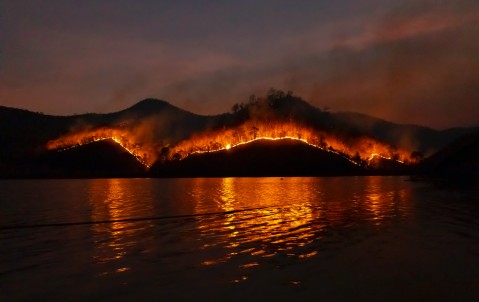Read the rest of the post ' Managing the reinsurance cycle '

Underwriting in a changing climate
As the effects of a warming world become apparent and continue to escalate, how can (re)insurers form a more accurate view of risk in an era of climate change? Hiscox Re & ILS’ Ross Nottingham, Dr Mike Palmer, Dr Keven Roy, and Nick Orton explore the value of applying a new underwriting framework.
The US literally burnt at a record rate last year. According to the National Interagency Fire Center, more than 10.3 million acres were destroyed by fire in 2020 compared to 4.7 million acres in 2019. CalFire reported that five of the top 20 largest California wildfires occurred in 2020. These unprecedented figures reveal how a changing climate and warming world are increasingly having a direct impact on climate perils ranging from wildfires to tropical cyclones like Japan’s Typhoon Hagibis – which itself generated a record-breaking loss of US$10 billion in 2019.
As insurers and reinsurers, these extreme numbers should – and do – concern us as we look ahead to a warmer world, with a likelihood of more intense natural catastrophes and a higher frequency and severity of claims. That said, despite the changing and challenging nature of the risk, it's an issue that the insurance and reinsurance industry is well placed to help with. We have, after all, been working to understand natural catastrophe risk for many decades, using tools like catastrophe models. But the fast-changing climate demands that we start to apply risk assessment tools like these in a different, smarter way.
For example, a climate change question might once have been: "If risk levels change by X in 2050, what will my current portfolio look like?” We don't think this is the most useful way to approach the climate challenge and it has some significant limitations. So, at Hiscox, we have come up with a new underwriting framework to better focus time, effort and resource for navigating the ever-increasing risks of climate change.
A new framework for climate change
Our climate change framework has four main areas. Firstly, we need to make an explicit decision about the timescales that are of most interest to us. Secondly, the framework considers the climate change signals and how strong they are (i.e. how easy they are to identify). Then we need to understand how sensitive the different perils are to changes in global temperature. And fourthly, as insurers and reinsurers, we need to prioritise the zones of our biggest exposures.
What does this new framework look like in practice? For Hiscox, the combination of these factors brings two specific perils into sharp focus: California wildfires and Pacific typhoons.
California wildfires
For California wildfires, the academic literature and our own research has established a clear correlation between severe wildfire activity and climatological conditions. This work has led us to introduce explicit adjustments to wildfire catastrophe models to account for climate change. This step ensures that current wildfire risk levels are represented in the models, rather than the average level of risk over the historical record. What we've witnessed with wildfire is a so-called secondary peril, only occasionally paid lip service to or sometimes not included in a rating, now producing meaningful losses to reinsurance layers, which materially impacts pricing and reinsurer margin.
Japanese typhoons
Turning to typhoon risk, before 2018 we only had three meaningful losses in the past 30 years to benchmark our pricing against. However, in a similar way to US wildfire, recent losses such as 2018’s Typhoon Jebi have led us to question the accepted understanding of this peril. Upon interrogation of the data, we observe a trend in warming sea temperatures in the North West Pacific correlating with an increased likelihood of stronger storms impacting Japan. This has increased our required price for reinsurance programs, an increase that importantly impacts the top ‘loss free’ layers as much as the bottom ‘loss impacted’ ones.
Roughly speaking, and bearing in mind the current level at which reinsurance layers are purchased, an industry typhoon loss of circa $5 billion is enough for the Japanese reinsurance market to run at a 100% loss ratio. This is not sustainable in our view, especially when set against a backdrop of increasing storm frequency. We have started paying more attention to our portfolio attachment profile and shining a spotlight on data quality, favouring clients who are able to accurately detail the exposures and locations in their portfolios. This helps us gain more confidence in our analysis and in our risk assessments, benefitting ourselves and our clients.
Implications for portfolio management
What then are the implications for portfolio management? The climate change issue is complicated, but we can mitigate some of that complexity and the uncertainty associated with it by asking some simpler questions. The first one is: “How robust are our portfolios – essentially what's the worst case that could happen and how do we manage those worst cases?”
The second question is: “How sensitive are our portfolios?” Many climate change questions ask about scenario in the far future. A better question to ask is: “What are the range of possible outcomes for a particular peril and can we develop a function that describes the sensitivity of our portfolio to a range of outcomes?” Although this is a difficult thing to do, accomplishing it would be hugely beneficial from an underwriting and portfolio management perspective.
Value in partnership
Even though we spend our lives working to understand natural catastrophes, the unknowns from climate change can be daunting. But they are not insurmountable. It is why we want to share our new framework approach with our clients and be as transparent as possible about what drives our decision making and underwriting. Better still, we value working with partners who have an opinion, a methodology of their own, and are willing to join us in thinking through new underwriting approaches towards climate change.
If you're interested in learning more, contact our team here.




